Holly’s Cow Peas — Authentic Country Cooking
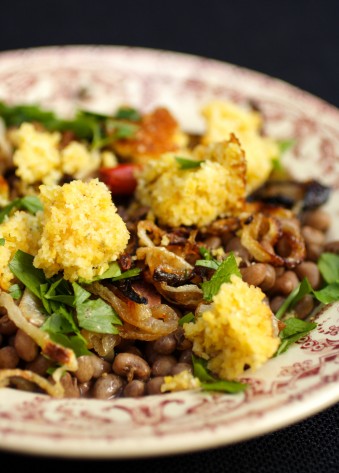
It’s honest, simple food that speaks plainly of its origins, its parts, and aspirations. It’s the humblest of food that fit for a king, and it’s startlingly delicious.
Like Hank William’s “Lost Highway,” it’s direct and from the heart; it cannot tell a lie. Like the vernacular dogtrot house or Frank Lloyd Wright’s Falling Water, it springs naturally from its place, its environment.
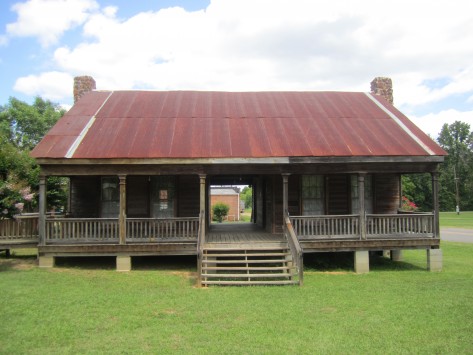
Dogtrot house

Fallingwater
That’s what authentic country cooking is, and that’s what Holly’s Cow Peas are. Or, at least, they’re made in the spirit of authentic country cooking. The browned onion topping and garnish of chopped parsley probably never appeared on a bowl of cow peas back in the day, but this is now.
Country cooking’s unfussy ways are the secret to its success and the root of our modern day disappointment with it: More than any other type of cooking, it’s only as good as the ingredients used.
That’s why the food revival going on in the South right now is so gratifying. From farmers and millers to chefs, bakers, and home cooks, more and more people want to grow, eat, and cook with regional heirloom and heritage ingredients that have a personality, a story. I hope this translates to a return to the kitchen and a greater number of cooks, who, buoyed by a food nativism that celebrates the best of the old while admitting new influences, embrace a sort of be here now approach to seasonal eating and cooking.
Holly’s Cow Peas is my latest be-here-now dish. Actually, it’s a hurry-up-and-be-here-now-before-it’s-too-late dish. In central Virginia, where I live, fresh cow peas are for the most part done for. By now most consumers have moved on to classic autumn foods and cow pea’s days are numbered (cow peas love heat but not cold). But my pink-eyed pea and Whippoorwill plants in my community garden plot are still producing nicely for me. While the getting is good, here is the method for making Holly’s Cow Peas.
* * * * * * * * * * * *
Holly’s Cow Peas, shown at the top of this posting, has four key elements: fresh cow peas seasoned with bacon grease, browned onions, crumbled skillet cornbread, and chopped fresh parsley. In combination, they create a soulful bowl of layered tastes and flavors: earthy and fatty and smoky topped with sweet and bitter. You will need to make your own cornbread because, to my knowledge, it’s not possible to purchase the style of cornbread that’s needed here: The not-sweet type that’s made entirely of cornmeal.
The first order of business is to make the well-browned onion slices, a process which takes patience, a generous amount of extra-virgin olive oil, and a medium to medium-low heat level. After thinly slicing an onion or two, put the onion slices in a large skillet with about 1/8 inch of olive oil. Season the onion with a couple generous pinches of salt and cook for a good long time (at least 30 minutes), stirring occasionally, until the onion slices have gone beyond being caramelized to becoming browned and crispy on the edges. The cooking technique is the same used to make the browned onion topping on a famous Arabic dish called Mujadara.
Then, while the onions are cooking down, down, down, make the cornbread. And while the cornbread is baking, make the cow peas.
Place shelled fresh cow peas in a pan and with enough water to cover them. Add a dollop of bacon grease (or a couple of slices of bacon or a piece of ham hock or some other smoky, porky bit), a chili pepper sliced in half lengthwise, a grinding or two of black pepper, a couple pinches of salt, and a couple of the pea pods from the shelled peas. (In his cookbook The Glory of Southern Cooking James Villas mentions in passing that traditionally some of the pea pods are added to the pot when cooking fresh cow peas. He doesn’t say why this is done, and I have no idea why myself, but I have a feeling it adds a depth of vegetal flavoring that would be missing otherwise. And perhaps it was a calling card for anyone looking into the pot to signal to them, yes, these are fresh shelled peas, a seasonal delicacy, and not the dried variety that you can get any time of year, mind you.)
Bring the peas to a boil, then lower the heat and gently simmer them with the lid on until the peas are fully tender but still firm, about 20 minutes. (When cooked, fresh cow peas have a lovely tender-firm texture that is unique to them, and can’t be obtained with dried peas.) When the peas are tender, taste them and add more salt if needed.
To serve, spoon a portion of the peas, along with some of the cooking liquid, into a bowl and top with some browned onions, crumbled corn bread, and chopped parsley. The cooking liquid will have turned a gray, mushroom color—or, if in a less flattering mood, the color of dirty dish water—which may be why most often cow peas are served drained and not with the “pot likker.” I figure, though, that there’s some nutrition and flavor in the cooking water, so I like to enjoy a bit of it in each spoonful for the crusty crumbled cornbread to soak up.
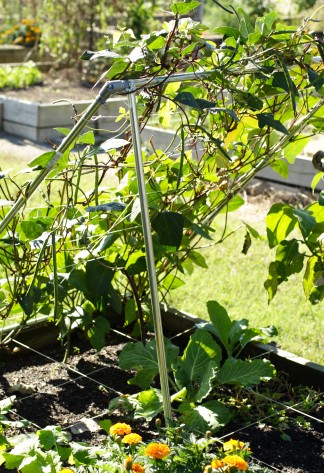
Trellised pink-eyed peas still going strong in mid-October.
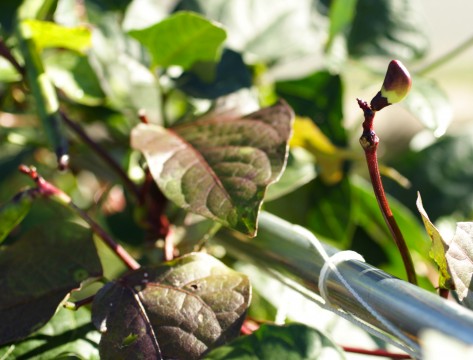
Pink-eyed peas
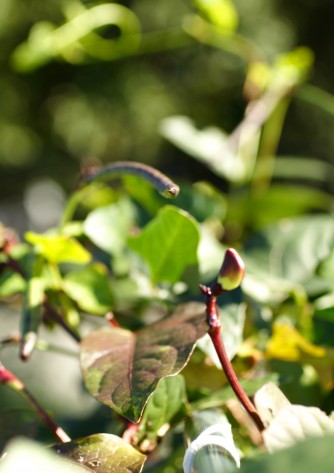
Pink-eyed peas
Photo credits:
Dogtrot house: By Billy Hathorn (Own work) [CC BY-SA 3.0 (http://creativecommons.org/licenses/by-sa/3.0) or GFDL (http://www.gnu.org/copyleft/fdl.html)], via Wikimedia Commons
Fallingwater: “Fallingwater, also known as the Edgar J. Kaufmann, Sr., residence, Pennsylvania, by Carol M. Highsmith” by Carol M. Highsmith – http://www.loc.gov/pictures/collection/highsm/item/2010630255/. Licensed under Public Domain via Wikimedia Commons
